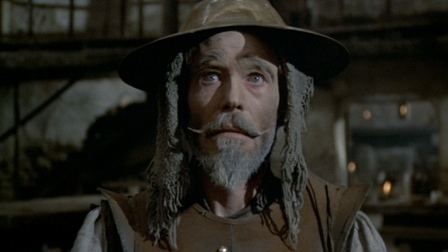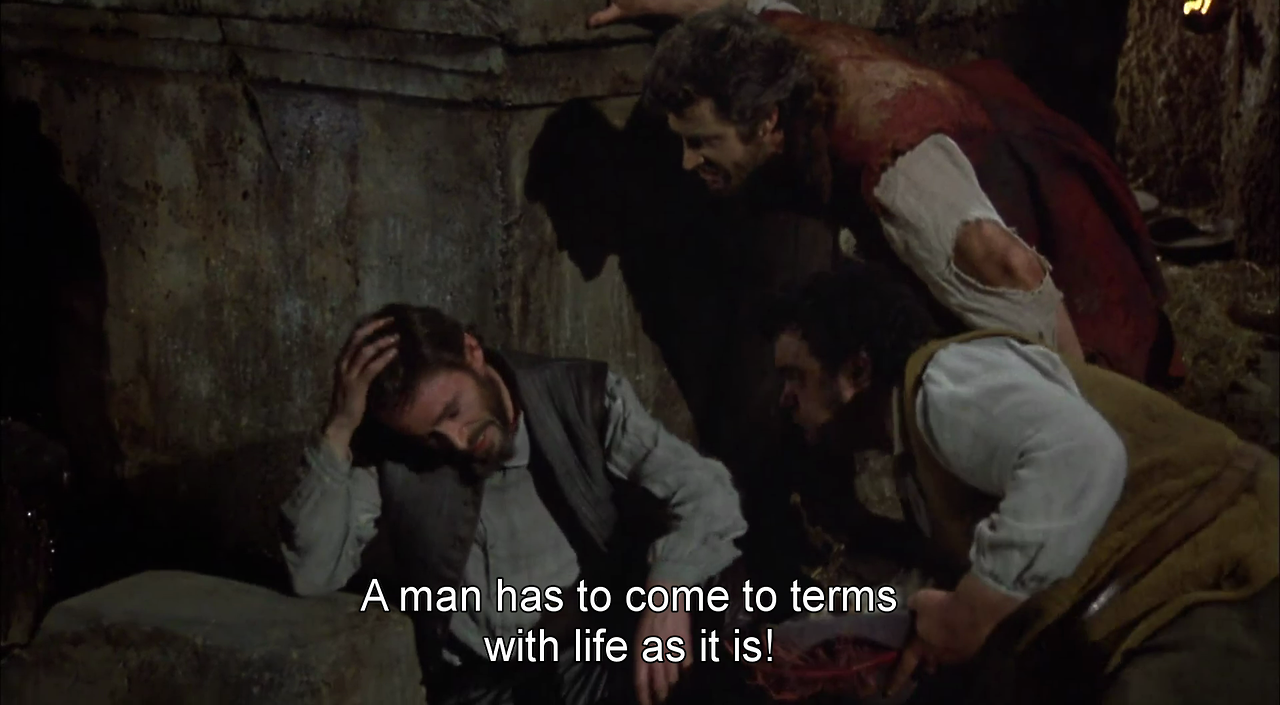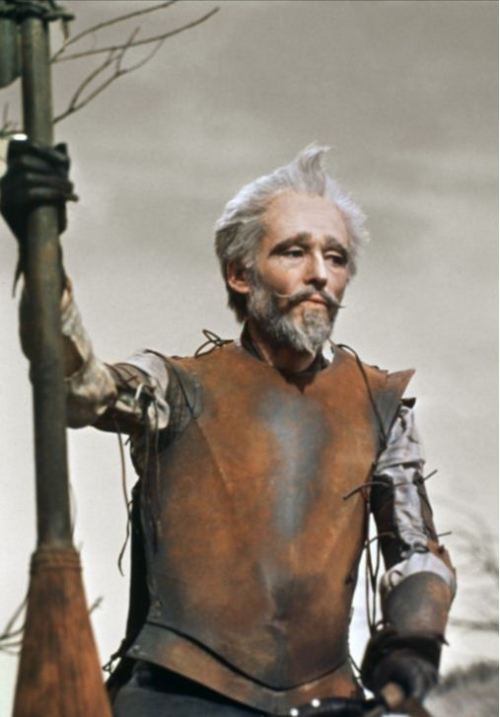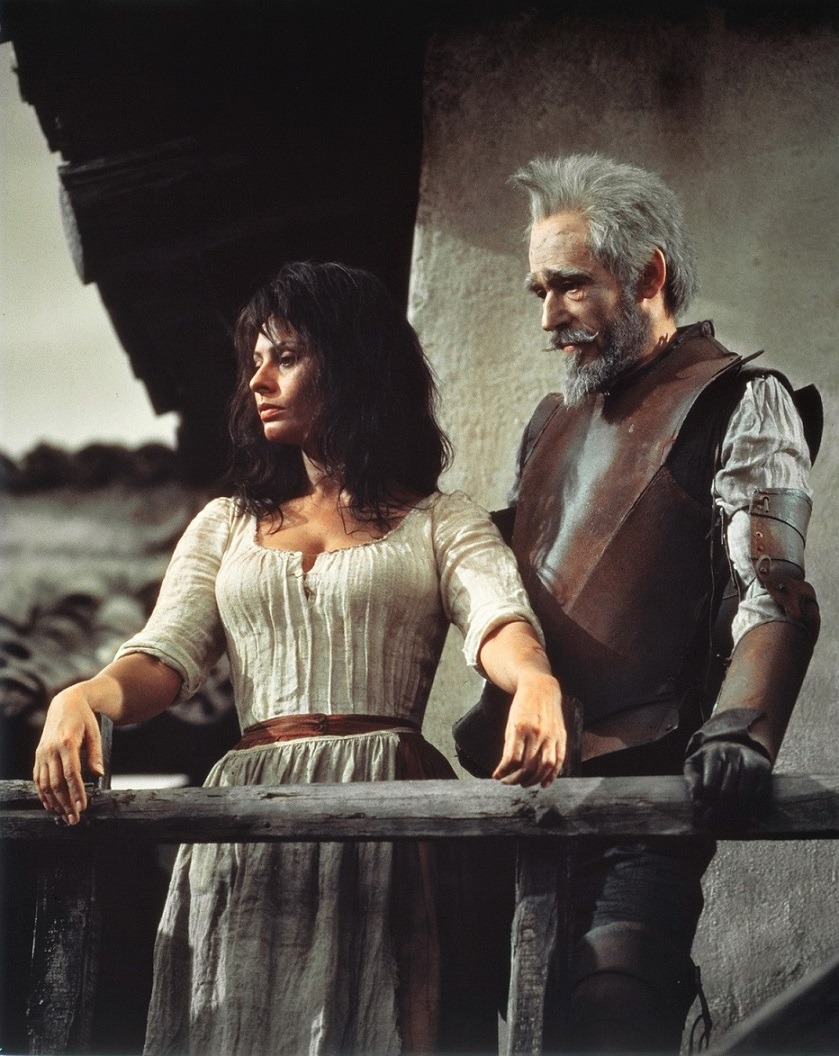Recentemente, durante a quinta temporada da
comédia da Netflix “Grace and Frankie”, Robert (interpretado por Martin Sheen)
fez parte de um grupo de teatro gay que decidiu produzir o musical “O Homem de
La Mancha”. Robert queria o papel de Dom Quixote, mas acabou sendo Sancho. Em
uma cena primordial na temporada, entretanto, Robert canta de maneira magnífica
a canção mais famosa do musical, “The Impossible Dream”.
Recently,
during the fifth season of the Netflix sitcom “Grace and Frankie”, Robert
(played by Martin Sheen) was part of a gay theater group that decided to
produce the musical “Man of La Mancha”. Robert wanted the role of Don Quijote,
but he ended up as Sancho. In a key scene of the season, however, Robert sings
beautifully the best known song of the musical, “The Impossible Dream”.
Esta trama me fez pensar no filme de 1972, “O
Homem de La Mancha”, que eu vi e amei durante minha fase de particular
interesse por Peter O’Toole, há mais de sete anos. Eu soube que era hora de
revisitar este filme querido estrelado por um dos meus atores favoritos, que
ainda vivia quando eu vi o filme pela primeira vez.
This
whole plot made me think of the 1972 film “Man of La Mancha”, one that I
watched and loved back in my Peter O’Toole phase, over seven years ago. I knew
it was time to revisit this old favorite starring an old and now gone favorite.
“O Homem de La Mancha” conta uma história dentro
de outra. No começo, o escritor e ator Miguel de Cervantes (Peter O’Toole) e
seu assistente (James Coco) são presos pela Inquisição durante uma peça. Na
prisão, eles encontram todo tipo de gente, todos dispostos a incomodá-los e a
queimar os manuscritos de Cervantes. Para salvar seus manuscritos, Cervantes
aceita ser julgado por um tribunal fajuto, e assim conta a história de Dom
Quixote.
“Man of
La Mancha” tells a story within a story. In the beginning, writer and actor
Miguel de Cervantes (Peter O’Toole) and his assistant (James Coco) are arrested
by the Inquisition as they’re doing a play. Once in the prison, they find all
kinds of people, and all willing to bother them and burn Cervantes’s
manuscripts. In order to save his manuscripts, Cervantes accepts to be judged
by a mock trial and thus tells the story of Don Quijote.
Esta é uma história muito conhecida. Alonso
Quijana era um homem velho que amava ler. Ele lei tantas histórias de aventuras
que ficou convencido de que ele era um cavaleiro chamado Dom Quixote de La
Mancha (novamente Peter O’Toole). Ele convence seu vizinho Sancho Pança (de
novo James Coco) a sair em missão ao seu lado. Dom Quixote confunde moinhos de
vento com gigantes, pobres estalagens com castelos, uma tigela de barbear com
um capacete dourado e a prostituta Aldonza (Sophia Loren) com a donzela
Dulcinea.
This is
a well known story. Alonso Quijana was an old man who loved to read. He read so
much adventure stories that he was convinced he was himself a knight called Don
Quijote de La Mancha (once again, Peter O’Toole). He convinces his neighbor
Sancho Panza (again James Coco) to go with him and be his sidekick. Don Quijote
confuses windmills with giants, poor inns with castles, a shaving pot with a
golden helmet and the whore Aldonza (Sophia Loren) with the damsel Dulcinea.
Enquanto isso, a sobrinha de Alonso Quijana,
Antonia (Julie Gregg) convence o noivo dela, Sanson Carrasco (John Castle) a ir
atrás do tio e fazê-lo olhar para o espelho da realidade - porque Alonso já se
tornou motivo de chacota na cidade. Ela diz que “só está pensando nele”, mas
sabemos que ela está mais preocupada com a sua própria reputação do que com o
tio louco.
Meanwhile,
Alonso Quijana’s niece Antonia (Julie Gregg) convinces her fiancée, Sanson
Carrasco (John Castle) to go after her uncle and try to makehim look at the
mirror of reality - because Alonso has already become laugh stock for the town.
She may say she is “only thinking of him”, but we know she is worried more
about her reputation than with her crazy uncle.
Miguel de Cervantes nunca considerou Dom Quixote
como sua melhor obra. Mesmo assim, ela é a mais lembrada atualmente, e foi o
primeiro de seus escritos a ser adaptado para as telas em um curta-metragem
francês de 1903. O musical, baseado em apenas uma parte da novela Dom Quixote,
estreou na Broadway em 1965 – mesmo tendo sido gerado como uma peça de
televisão! O autor Don Wasserman foi chamado pelo diretor musical Albert Marre
para transformar sua malsucedida obra de televisão em um musical... e assim a
história foi feita.
Miguel
de Cervantes never considered Don Quijote as his best work. Nevertheless, it is
now his best remembered, and it was the very first of his writings to be
adapted to the screen in a 1903 French short film. The musical, based on only a
part of the Don Quijote novel, opened on Broadway in 1965 - even though it
started as a non-musical teleplay! The writer Don Wasserman was approached by
musical director Albert Marre to turn the unsuccessful teleplay into a stage
musical... and history was made.
“O Homem de La Mancha, o musical, ganhou cinco
prêmios Tony, incluindo um de Melhor Musical. Logo Hollywood se interessou, e
Wasserman foi contratado para escrever o roteiro. Marre foi contratado para
dirigir, mas foi demitido logo depois por não ter experiência no cinema. No
final, Arthur Hiller dirigiu o filme. Obviamente, muitas falas e músicas
inteiras tiveram de ser cortadas da peça – e o filme ainda acabou tendo mais de
duas horas de duração!
“Man of
La Mancha”, the musical, won five Tonys, including one for Best Musical. Soon
Hollywood was interested, and Wasserman was hired to write the screenplay.
Marre was hired to direct, but fired little after due to his lack of film
experience. In the end, Arthur Hiller directed the film. Of course, many lines
and whole songs had to be cut for the movie - that still managed to run over
two hours!
Kirk Douglas tentou conseguir o papel principal,
mas Peter O'Toole foi escolhido para ser Cervantes / Dom Quixote. O'Toole
gravou as músicas mas, ao perceber que não cantava bem, procurou alguém para
dublá-lo, e assim encontrou o cantor Simon Gilbert. Mesmo sem cantar, O'Toole
trouxe emoção para a personagem, o que foi essencial. Sophia Loren cantou suas
canções. James Coco está ótimo e divertido, como um bom Sancho deve ser. O
filme foi gravado nos estúdios de Dino di Laurentiis em Roma.
As for
the leads, Kirk Douglas actively campaigned for the role, but Peter O’Toole
ended up as Cervantes / Quijote. O’Toole recorded his songs but, seeing his
singing wasn’t good, looked for someone to dub him, and ended up with Simon
Gilbert. Even without singing, O’Toole brought a lot of emotion to the
character, which was essential. Sophia Loren did her own singing. James Coco is
as great and funny as Sancho should be. The film was shot at the Dino di
Laurentiis studios in Rome.
Todas as transições da prisão para os cenários
da história de Dom Quixote são fantásticas – se você piscar, perderá um grande
trabalho de edição. Há também uma cena organizada como se os personagens fossem
peças em um jogo de xadrez – é brilhante. O estilo do filme é rústico, do
interior mais pobre. Sophia Loren queria que o filme fosse gravado em
Andaluzia, na terra de Cervantes, entretanto eu acredito que o estilo rústico
foi determinante para evocar o século XVI.
All the
transitions from the prison to the scenarios of the Quijote story and back are
fantastic - you blink and you’ll miss the great editing work. There is also a
scene played as if the characters were pieces in a chess game and it’s
brilliant. The overall look of the film is raw, from the poor countryside. Even
though Sophia Loren wished to film in the beautiful Andalucía, Cervantes’s
home, I believe the rustic look made the film evoke the 16th century well.
O principal legado de “O Homem de La Mancha” é,
sem dúvida, a música “The Impossible Dream”. Gravado por cantores e cantoras –
incluindo Frank Sinatra e Cher – e com versões em diversas línguas, hoje a
canção pode ser considerada mais famosa do que a própria peça.
The
main legacy of “Man of La Mancha” is, without a doubt, the song “The Impossible
Dream”. Recorded by both male and female voices - including Frank Sinatra and
Cher - and with versions in several languages, now the song can be considered
more famous than the play itself.
Como curiosidade, uma vez, para uma performance
da peça para a caridade, Martin Sheen interpretou o protagonista de “O Homem de
La Mancha”. E assim voltamos ao começo do artigo, da mesma forma como o filme
volta ao começo de suas histórias concatenadas.
As a
curiosity, once, for a charity performance of the play, Martin Sheen played the
lead of “Man of La Mancha”. And thus we come full circle with this post, just
like the film comes full circle with its intertwined stories.
No começo do falso julgamento, Cervantes é
acusado de ser um idealista quando ele diz que o mundo é um lugar ruim, e que a
realidade é inferior à ficção. Alonso Quijana estava tão insatisfeito com a
realidade que preferiu viver uma vida de ilusão. Eu já pensei que ficção e
ilusão são melhores e muito mais interessantes que as lutas e os absurdos da
vida real. Cervantes pode ter tentado nos ensinar a lição de que não podemos
confundir realidade e ficção, mas com “O Homem de La Mancha” temos uma mensagem
mais poderosa: a ficção existe para nos inspirar a enfrentar a vida e, às
vezes, podemos trocar uma pela outra – mesmo se isso soar como um sonho
impossível.
In the
beginning of the mock trial, Cervantes is accused of being a idealist when he
says the world is a bad place, and reality is inferior to fiction. Alonso
Quijana was so dissatisfied with reality that he preferred to live a life of
illusion. I’ve felt that fiction and illusion are better and way more
interesting than the struggles and absurd of real life. Cervantes might have
wanted to teach us the lesson that we can’t mistake fiction for reality, but
with “Man of La Mancha” we get a more powerful message: fiction exists to
inspire us to face real life, and sometimes, we can trade one for the other -
even if it sounds like an impossible dream.
This is
my contribution to the Second Annual Broadway Bound blogathon, hosted by Rebecca at
Taking Up Room.
:format(jpeg):mode_rgb():quality(90)/discogs-images/R-1985327-1511730310-2576.jpeg.jpg)







2 comments:
I appreciate and agree with the life lesson you take from Man of La Mancha.
I must confess that I have never seen the film. I so loved the touring stage production I saw with Richard Kiley reviving his Broadway role that I can't bring myself to watch another.
About twenty-five years ago I had the pleasure of seeing "Man of La Mancha" in San Francisco--it had Raul Julia, Sheena Easton, and Tony Martinez in it, and it was fantastic. Your wonderful post brought back a lot of memories, and I can totally see O'Toole in the role of Quixote. He had the tall and skinny thing down pat, that's for sure. Thanks again for joining the blogathon, Le!
Post a Comment